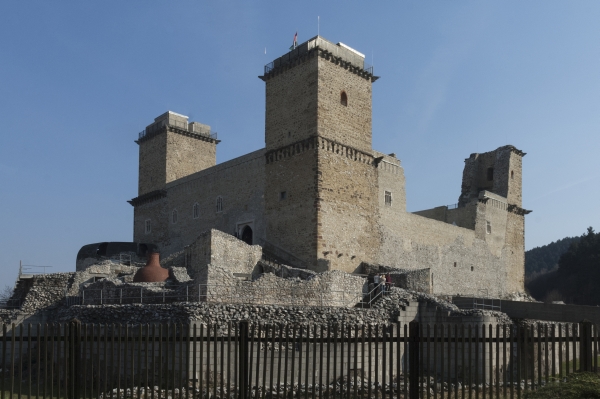The Unity of Illusion
The Reconstruction of the Castle in Diósgyőr
Architects: Gyula Cséfalvay, Judith Botos
Text: Anna Zöldi
Photos: Gyula Cséfalvay

The castle of Diósgyőr was restored in the 60s and the complex opened in 1968 is a witty example of the restoration of historic monuments carried out in the spirit of the Venetian chart whilst also being an emblematic piece of the glorious and heroic era of the history of the protection of historic monuments in Hungary. Although modern back in those days, this restoration project failed to meet contemporary demands of the local management of the town and because of the technical features of the structures it started to deteriorate. In the first round, architects of the Botos–Cséfalvay team were commissioned in 1999 with the modernization project of the restoration by Ferenczy, whilst designs respecting the original outlines to the full had been completed as late as by 2003. The architecture which had been several centuries old was revived by using contemporary technology, manually built masonry, shuttered with a multitude of scaffoldings, high-quality materials and excellent labour work. Designers ambitioned to meet traditional concerns of the protection of historic monuments too, as well as to precisely distinguish between the new and the original parts, whilst the genuine function of architecture here was to create the illusion of an integral unity. Masonry was built now by using stones slightly different in colour from that of the original which were also easy to carve. Masonry made by using fill-in stone materials was inserted between the outer and inner layers of the stone walls. As stone carvings were made of limestone, the overall impression simultaneously refers to the abstracting tendencies of contemporary architecture.
Sustainability works (1999–2015)
Architecture: Botos-Cséfalvay Építész Iroda, Botos Építész Iroda
Leading architect: Gyula Cséfalvay
Architect: Judith Botos
Structure: László Fodor
Electrical engineering: András Hágen
Roads, public utilities: Antal Türk
Reconstruction (2010–2015)
Reconstruction studies: György Szekér
Leading architect: Gyula Cséfalvay
Architect: Judith Botos
Fellow architects: Ágnes Gáspár, Attila Gasparovics, András Bögös, András Győrfi, András Abkarovits, Péter Cséfalvay
Stone carvings design: György Szekér
Interiors: István Ferencz DLA, János Hidasnémeti
Exhibition: Dr. Emese Lovász
Structure: Csaba Horváth, Csaba Kovács
Insulation: Sándor Horváth – Pataky és Horváth Építész Iroda
HVAC: Erzsébet Balogh
Electrical engineering: Dezső Szűcs
Main contractor: ZERON Zrt.
Construction manager: Gábor Pandur
Stone restoration: Gergely Kelecsényi, later Gábor Ludányi
Masonry: Papp Kft.
Stoneworks: Reneszánsz Zrt.
Client: Miskolc Megyei Jogú Város Önkormányzata
Monument expert: Miklós Okrutay, Sándor Németh
Archeology: Dr. Emese Lovász, Gábor Szörényi
Chapel interiors: László Rostás






